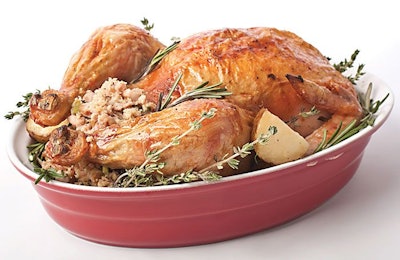
The turkey industry is looking to increase demand and sales for its product through a comprehensive, seven-point plan aimed at consumers both in the U.S. and abroad.
As part of the National Turkey Federation (NTF)’s annual meeting in San Diego, California, on February 22, Gary Cooper spoke about how the industry group’s turkey demand project is changing for 2018. After seeing positive results in the project’s first three years, the group reflected on what it learned so far and how it could improve going forward.
The result, the Van Wert, Ohio, turkey company’s chief operating officer said, is the creation of seven, executive-driven working groups of industry professionals that will focus on a key issue for the future of the protein. The groups will meet and speak regularly to advance their mission.
1. Animal health products
The turkey industry, due to its size compared with the global broiler meat market among other factors, is lacking in effective treatments of certain diseases. The rollback of antibiotic growth promoters and the re-emergence of diseases once managed by antibiotics compounds this health issue.
To address this challenge, this NTF group will focus on accelerating the research and development of new animal health products needed to replace products the industry lost, or for which uses have been restricted, and to address diseases for which no fully effective treatment or prevention options are currently available.
Cooper said former Jennie-O Turkey Store President Glenn Leitch led the formation of the group, and in the future it will be led by Circle S Ranch President Ronnie Parker.
2. Export
This group – led by Phil Seger, director of human resources at Farbest Foods Inc. – will work to identify and prioritize potential export markets with an opportunity to either be reopened to U.S. turkey exports or expand U.S. exports in the near future. The NTF wants to primarily focus on ways to build support for lowering and ultimately removing barriers to unrestricted turkey exports in each country.
While turkey is a popular choice in the U.S., few other countries consume the meat in significant quantities. Turkey exports were pushed down after 2014, Cooper said, because of concerns related to the outbreak of highly pathogenic avian influenza in the U.S., but those bans are starting to lift and demand for turkey exports is increasing. Currently, the top five turkey importers are Mexico, Japan, Canada, Hong Kong and the Dominican Republic.
Cooper said NTF is focused on getting access to markets it’s currently shut out of, and it’s asked its allies at the USA Poultry & Egg Export Council to focus on that mission. For now, the industry’s top export targets are Australia, China, India and countries in the Middle East.
3. Education
The education group, led by Aviagen Turkeys President Jihad Douglas, will focus on disseminating the NTF’s agriculture curriculum to middle schools around the country. The goal of the NTF curriculum is to teach school children how to evaluate conventional agriculture’s role in feeding a growing and hungry world. This group will work alongside the Future Farmers of America.
Cooper said the group wants to make sure school children aren’t being influenced by teachers with a vegan agenda or taught that veganism is a preferable alternative to eating meat. The FFA will help promote the entire barnyard to this audience.
4. Social media/digital online
The NTF’s promotional effort is already making great advances through activities on social media encouraging people to try turkey. Cooper said this group – lead by Butterball LLC CEO Kerry Doughty – will build on that effort. This group will focus on creating social media and online digital campaigns aimed at maximizing public engagement. The objective is to be a leader among meat proteins.
Cooper said NTF is committed to this strategy in the long term, too. In fact, it plans on hiring a full-time staffer focused entirely on online and social media campaigns.
5. Institutional purchases
This group, led by Protein Alliance Inc. President Carl Wittenberg and Jennie-O Turkey Store President Steve Lykken, aims to establish a group of foodservice professionals to advise the turkey industry on ways to improve consumption of turkey in school meals.
6. Product innovation
Just as the chicken industry saw the chicken wing go from by-product to hot item, the turkey industry is looking for a new product to entice both chefs and the average consumers. This group, led by Cargill Protein Ingredients & International President John Niemann, plans on utilizing current products in the industry that could be elevated to different platforms to expand the long-term value of turkey products.
In the long term, the group wants to create an outlet for the industry to develop cuts of turkey driving up interest and demand in the protein. Niemann brings useful experience from working in the beef industry, Cooper said.
7. Promotional events
The final group, led by Cooper, will continue to focus on live events designed at getting people to try turkey, learn about its value as a food and ingredient and dispel any misinformation about the meat and the animal. This group will build on the existing efforts of the turkey demand project and try to improve on them.
One example of a promotion done right, Cooper said, was the inclusion of turkey as a protein group at the American Royal World Series of Barbecue in Kansas City, Kansas, for the first time in its 38 year history. The event is one of the largest in the competitive barbecue circuit. During the event’s four-day run, NTF’s “Serve Turkey” social media accounts brought in as much traffic as they typically would over a month’s time. That event should serve as a model for how the industry can spread goodwill and grow demand for its product.

















